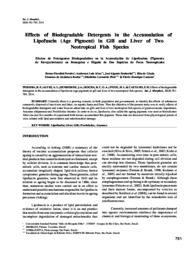Effects of biodegradable detergents in the accumulation of lipofuscin (age pigment) in gill and liver of two neotropical fish species.
Effects of biodegradable detergents in the accumulation of lipofuscin (age pigment) in gill and liver of two neotropical fish species.
Author(s): PEREIRA, B. F.; ALVES, A. L.; SENHORINI, J. A.; ROCHA, R. de C. G. de A.; PITOL, D. L.; CAETANO, F. H.
Summary: Currently there is a growing concern, in both population and governments, to identify the effects of substances commonly disposed of into rivers and lakes, on aquatic fauna and flora. Thus the objective of the present study was to verify effects of biodegradable detergents and water from an urban lake on gills and liver of two neotropical fish species of great economic importance, Astyanax altiparanae and Prochilodus lineatus. In order to do so, lipofuscin, also called the ageing pigment, was used as bioindicator. After one and five months of experiment both tissues accumulated this pigment. These data are discussed from physiological points of view, related with lipid peroxidation and mitochondrial damage.
Publication year: 2014
Types of publication: Journal article
Keywords: Astyanax, Biodegradação, Brânquia, Detergente, Detergents, Figado, Fish, Gills, Lipofuscina, Liver, Peixe, Pigmento, Pollution, Prochilodus
Observation
Some of Embrapa's publications are published as ePub files. To read them, use or download one of the following free software options to your computer or mobile device. Android: Google Play Books; IOS: iBooks; Windows and Linux: Calibre.
Access other publications
Access the Agricultural Research Database (BDPA) to consult Embrapa's full library collection and records.
Visit Embrapa Bookstore to purchase books and other publications sold by Embrapa.

